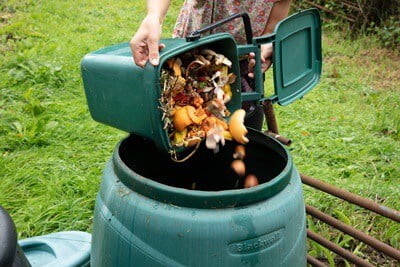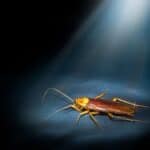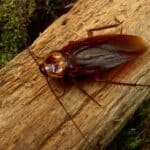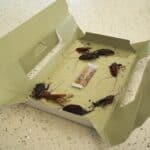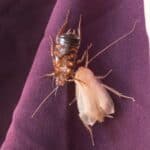Nobody wants to find cockroaches in their compost pile. If you use your compost bin correctly, you shouldn’t have a problem, but there are times when you’ll need to take action to get rid of cockroaches.
Cockroaches live in compost because it’s an abundant food and moisture source. You can remove cockroaches with diatomaceous earth, increasing the compost’s temperature, covering it with a container, and using chickens as pest control. Note that cockroaches are decomposers that fertilize waste that you add to a compost pile.
Compost is often kept close to homes, so it’s natural to be concerned about getting a cockroach infestation. Most cockroach species don’t infest homes, so you’re unlikely to be affected. However, there are ways to keep cockroaches away from your compost heap or remove them entirely.
Will Compost Attract Cockroaches?
If you use your compost bin correctly, you’re unlikely to have a pest problem. Compost piles should have a 20:1 ratio of carbon to nitrogen materials.
Carbon includes dried materials, such as straw, branches, leaves, and shredded twigs. Nitrogen materials include grass clippings and vegetable matter. When you mix carbon and nitrogen materials in the correct quantities, the compost should smell earthy and pleasant, not pungent.
Unfortunately, as soon as you add too many nitrogen-based materials, such as decaying meat, grease, and dairy, to the compost, it’ll start to smell. This is when you’re most likely to get a cockroach problem.
Cockroaches are attracted to rotten stenches because an abundant food source usually accompanies them.
Do Cockroaches Live in Compost?
Cockroaches predominantly feed on waste, including rotting and decaying food. As described by Biotropica, cockroaches are a clade of detritivore-herbivore insects. This means they eat all kinds of garbage.
There aren’t many things that cockroaches won’t eat. They commonly feast on:
- Meat carcasses
- Decaying fruit and veg
- Newspaper
- Food scraps, such as potato peel and avocado skins
- Leaves and grass clippings
You likely keep your compost outside, either exposed or in a bin. This means cockroaches have easy access to drainage pipes, hoses, watering cans, and frost – all of which offer ample hydration. Water, food, and shelter are all cockroaches need to survive, so compost makes an ideal home.
While compost is a great way to utilize food scraps instead of throwing them away, cockroaches will be drawn to it, especially during the night. Compost provides the nutrients that they need to survive and keeps them protected.
Why Are There Cockroaches in My Compost Bin?
Compost bins create the ideal environment for cockroaches to live in. Not only do they provide an abundant source of food, but they contain the moisture that cockroaches need to survive.
Cockroaches also forage in groups. Unfortunately, if you see a cockroach in your compost bin, there’s likely more lurking nearby or hiding inside. That’s because cockroaches communicate in several ways to alert each other about available food.
Communication methods include:
- Stridulation: Wild cockroaches create friction with their wings and legs by rubbing them together. They also open and close holes in their exoskeleton to make a soft chirp.
- Pheromones: According to Chemistry of Pheromones and Other Sociochemical, pheromones allow cockroaches to give commands to one another.
- Aggregation Pheromones: This pheromone is specifically used to get cockroaches in one area as a large group. They’re made up of skin, poop, and fatty acids.
You’re most likely to find cockroaches in your compost during winter as it provides warmth and shelter.
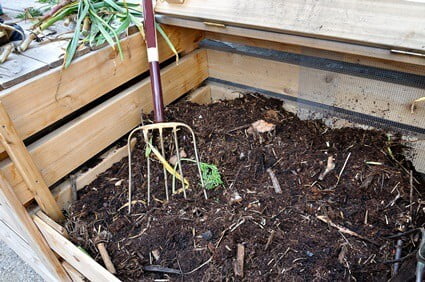
How To Get Rid of Cockroaches in Compost Bin
If you suspect that there are cockroaches in your compost bin, inspect it at night with a torch.
When doing so, turn the pile to find pests that have rooted themselves in deep. If cockroaches live amongst the composting matter, you should see them scurrying for cover as you expose them.
You can remove cockroaches in compost with the following:
Diatomaceous Earth
Diatomaceous earth is one of the most effective natural pest control treatments. Over the years, cockroaches have developed a resistance to pesticides, meaning they’re not as effective.
Also, you probably don’t want to use chemicals in your compost to prevent contamination, particularly if you’re planning to use them later in your garden. That’s where natural pesticides come in.
Diatomaceous earth is a naturally occurring powder that’s extracted from diatoms. It looks and feels like sand, but it’s much finer, consisting of 80% to 90% silica. When a cockroach comes into contact with it, the silica absorbs the water, oils, and fats from the cockroach, killing it over the next 2 weeks.
Increase the Compost’s Temperature
Compost needs to be between 130 to 160 degrees Fahrenheit for decomposition to happen. Not only that, but cockroaches can’t nest and reproduce at these temperatures.
If you’ve created your compost pile with the right material ratio, it should naturally generate heat. However, the compost won’t be hot enough if you’ve got too much carbon.
To increase the heat, add an activator, such as:
- Chicken manure
- Horse manure
- Weeds
- Waste coffee grind
- Blood meal
- Volcanic rock
You can purchase these items from a garden center.
Avoid putting large branches and thick piles of grass into your compost heap at once, as these will reduce the amount of heat that your compost pile can produce.
Chickens
Chickens need an open compost pile and provide an alternative form of pest control. Cockroaches are nutritious, so chickens will eat them if they come across any.
Chicken manure is also an effective compost activator, which is beneficial to the compost.
How To Keep Cockroaches Out of Compost Bins
To keep cockroaches out of your compost bin, you must make it unappealing. You might also need to seal cracks and gaps to stop cockroaches from squeezing in.
Keeping cockroaches out of compost is achievable with these steps:
Seal Off Access
One of the most fool-proof ways of stopping cockroaches in their tracks is to seal off access points to your compost.
If you don’t already have a sealed container for it, it’s sensible to get one. A closed-reactor or in-vessel system is recommended as they’re already fully enclosed.
You could cover the compost with a plastic sheet to stop cockroaches from gaining access. When adding organic matter to the pile, place a layer of soil or plant matter over the top to hide the scent.
If you’ve got your compost in a secure container, inspect the outside and lid for any small spaces. Adding a layer of gravel up to 12 inches wide around the container should deter cockroaches as they can’t eat it.
Turn the Compost
Regularly turning the compost pile displaces cockroaches and their hiding spots. Whenever you add fresh materials to the pile, place them in the center as you turn the rest of the matter over. By burying the materials, instead of letting them lay right at the top, you’ll hide them from cockroaches.
Turning the pile is also beneficial in other ways, as it increases the temperature, killing harmful pathogens. If you don’t want to do this by hand, an aerator is beneficial.
Add More Water
Your compost pile should be 40% to 60% water. You should be able to squeeze water out of your compost pile, but it shouldn’t be soggy or saturated.
If you think your compost pile’s too dry, add more water. This will make it more difficult for cockroaches to navigate, and they won’t enjoy sitting in water as they’re poor swimmers.
To test your compost’s water levels, put on some gloves, pick up a handful of compost, and squeeze it. It should feel like a wet sponge. Rather than placing water into the compost in one go, add it gradually.
Limit Food Waste
Consider how much food waste you put into it to keep cockroaches away from your compost pile.
If you add too much in one go, it’ll smell and cockroaches will be attracted to it. Adding food waste gradually is recommended until you know your compost pile is safe from cockroaches.
Whenever you add new food to the pile, ensure that it’s mixed with a dry material to offset the tempting odor.
Are Cockroaches Compostable?
Like all other living things, cockroaches decompose within 1-3 days. As they do, their bodies release water, nutrients, and energy back into the ecosystem.
Dead cockroaches fortify the soil within a compost pile, eventually giving life to plants and other greenery.
Are Cockroaches Good for Compost?
According to Indiana Public Media, cockroaches are decomposers that break down what they eat.
Because cockroaches are detritivore-herbivore insects, they eat detritus, including leaf litter, rotting fruit, and decaying matter. These are all things that you’re likely to add to the compost pile.
By feasting on the food remnants stored in a compost bin, cockroaches process them, turning them into fertilizer. Their bodies can cope well because they contain bacteria and protozoa that convert waste into nutrients.
Cockroach waste nourishes plants. Organic matter, such as leaf litter and wood, traps nitrogen. When cockroaches eat them, they release nitrogen into the soil through their feces, nourishing plants and trees.
Wood roaches are most beneficial for compost. They’re chestnut brown with a flat, oval body and spiny legs. They’re different from American and German cockroaches, but they’re commonly confused because they look similar.
They live outside but sometimes wander into homes by mistake. Human homes are unsuitable for wood roaches.
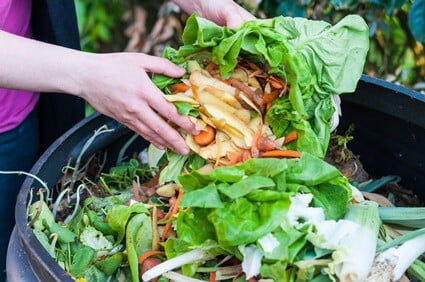
Why Do I Have Cockroaches in My Yard at Night?
Cockroaches are nocturnal, so they’re most active and alert after dark. Sadly, this makes them difficult to spot in the yard unless you look closely or know where to find them.
Not only will you find cockroaches in your compost, but they’ll hide in:
- Flowerbeds, especially mulch
- Garbage cans
- Wood piles
- Piles of leaves and debris
- Inside tree holes
- Around drains
The cockroach species you’re most likely to find outside include:
- Florida woods
- American
- Oriental
- Smoky brown
- Brown-banded
- Turkestan
Yards are a haven for pests. If your yard is wet or moist, cockroaches will be drawn to it. This is even more likely if you have leaf and wood piles that cockroaches use for shelter and sustenance.
Cockroaches hide in fissures and cracks in walls, and gaps under patios. In the daytime, it’s doubtful that you’ll ever spot them as they’ll be tucked away.
Yards lead to the home, so seal all cracks and gaps to stop cockroaches from squeezing through. If you have any damaged soffits or window screens, replace them. Cockroaches can get through the smallest of gaps.
This applies to caulk openings around pipes, plumbing, windowsills, doors, and electrical outlets. Seal all drains with a fine mesh screen so they can’t get inside.
